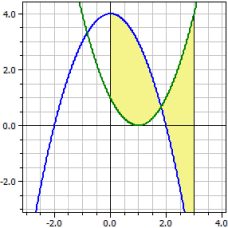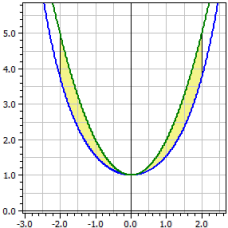Integral Calculus
Calculates the oriented and the absolute content of the area between two function curves in a desired interval, i.e. the two integrals.
Also determined:
- the moments of rotation around x- and y-axis,
- the bodies of revolution covered, and
- the arc lengths in the interval [a; b] and
- the center of gravity of the area (if A1=A2).
Example 1:
ƒ1(x) = 4-x^2 ƒ2(x) = (x-1)^2 Interval from von 0 to 3 Oriented content : A1 = 0,00000 Absolute content : A2 = 9,50675 Twisting moments : Mx = 9 My = -9 Bodies of revolution : Vx = 56,5487 Vy = -56,5487

Example 2:
Arc length of the chain line compared to the normal parabola y=x2+1.
ƒ1(x) = cosh(x) ƒ2(x) = x^2+1 Limits of integration from -2 to 2 Oriented content : A1 = -2,07961 Absolute content : A2 = 2,07961 Arc lengths : L1[a;b] = 7,254 L2[a,b] = 9,294

Please note:
The integrals are calculated using numerical methods. In principle, these reach their limits for functions with a very fast change of sign.
See also:
Supported FunctionsSetting the graphics

